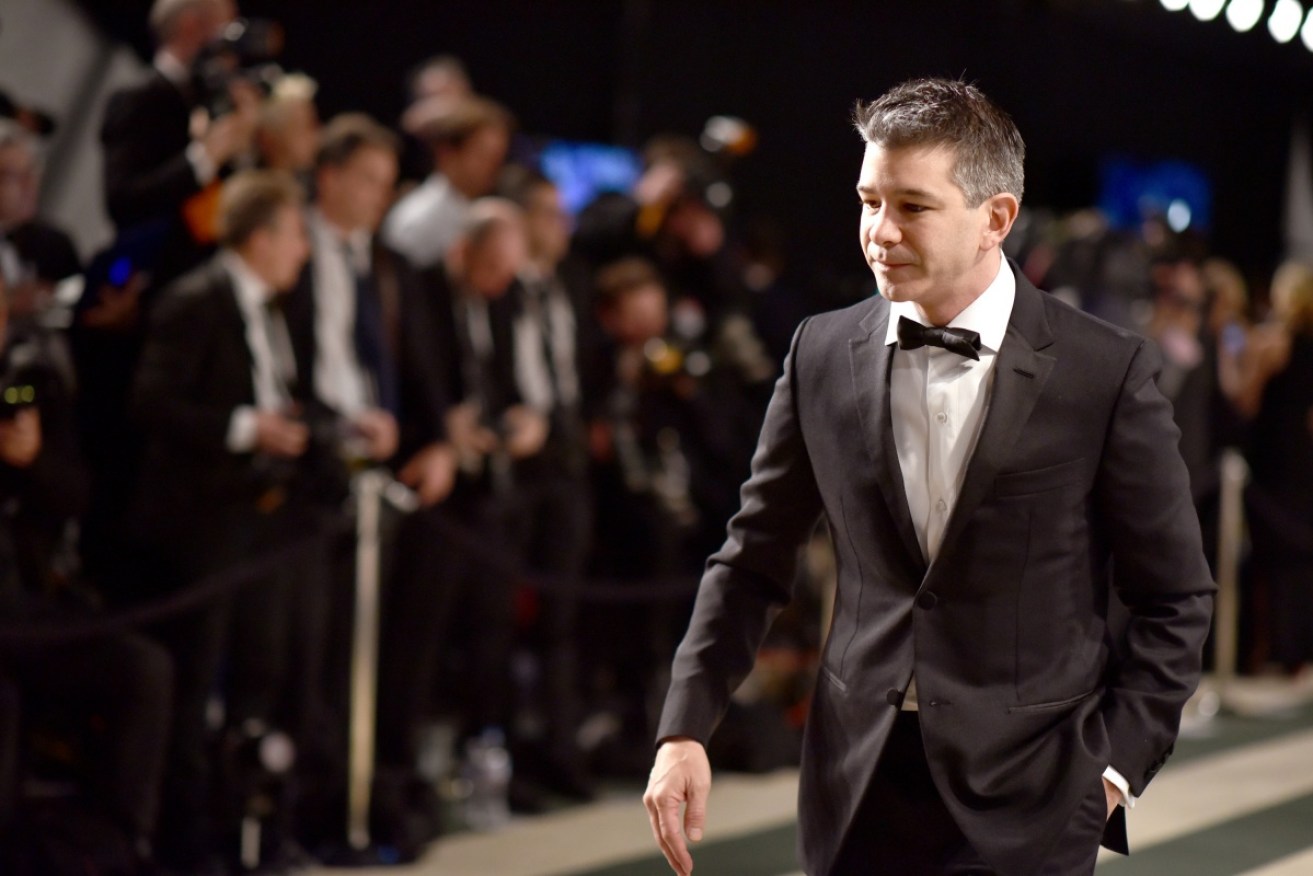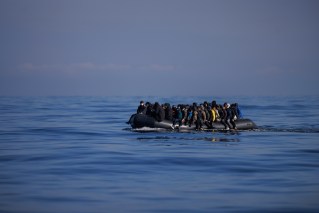Uber chief executive Travis Kalanick plays with fire

Uber founder Travis Kalanick Travis' ambition has led to risk-taking that could put his company on the brink of implosion. Photo: Getty
Continued…
Through an Uber spokesman, Mr Kalanick declined an interview request. Apple declined to comment on the meeting with Mr Cook. Many of the people interviewed for this article, who revealed previously unreported details of Mr Kalanick’s life, asked to remain anonymous because they had signed nondisclosure agreements with Uber or feared damaging their relationship with the chief executive.
Mr Kalanick’s pattern for pushing limits is deeply ingrained. It began during his childhood in suburban Los Angeles, where he went from being bullied to being the aggressor, continued through his years taking risks at two technology startups there, and crystallised in his role at Uber.
Selling Efficiency
Mr Kalanick grew up in the Northridge neighbourhood of Los Angeles. His parents, Bonnie and Donald Kalanick, made sure he and his brother, Cory, were never left wanting. He was naturally athletic and competitive, and excelled at running track and playing football.
At Patrick Henry Middle School, he was a wiry student who got good grades – putting him in the sights of some older kids who picked on him. Mr Kalanick later vowed never to be bullied again and turned the tables on his tormentors.
He also showed signs of entrepreneurialism. One summer, he sold knives door-to-door for the cutlery company Cutco. At 18, he started New Way Academy, his own SAT prep business, with a partner.
The startup life soon called to him. After attending the University of California, Los Angeles, to major in computer engineering, Mr Kalanick dropped out in 1998 to form a startup with several classmates. The company, Scour, became a peer-to-peer file exchange similar to Napster, which let people digitally share music and media files through legally dubious means.
Scour, which was eventually sued for $250 billion for alleged copyright infringement, filed for bankruptcy in October 2000, a move that protected it from the suit. The failure did not stop Mr Kalanick from helping to found another Los Angeles startup, Red Swoosh, four months later. Red Swoosh made a technology to efficiently transfer large files of digital data; one of its investors was Mr Cuban.
Sean Stanton, Red Swoosh’s former vice president for sales, said of Mr Kalanick: “Scour was about efficiency. Swoosh was about efficiency. It’s just the way his brain is wired. It’s like the way Uber works right now: What’s the fastest, cheapest and most efficient way to get from point A to point B? That consumes him, and all parts of his life.”
With Red Swoosh, Mr Kalanick started exhibiting his hallmark aggressiveness. When the company struggled, Mr Kalanick and a partner took the tax dollars from employee paychecks — which are supposed to be withheld and sent to the Internal Revenue Service — and reinvested the money into the start-up, even as friends and advisers warned him the action was potentially illegal.

Photo: Getty
With Mr Kalanick desperate to keep Red Swoosh afloat, he moved back into his parents’ house. He staved off bankruptcy for a second time by raising another round of funding. The wayward tax dollars eventually went to the IRS.
Mr Kalanick also decamped to Thailand with his software team in April 2006 to save money by living cheaply abroad, while also using the trip as a team-building exercise.
He was interested not only in business during this time. In 2003 he picked up a registration form to run for governor of California and registered a website, travis4gov.com, positioning himself as an independent candidate — though he never followed through with a campaign. In other personal pursuits, he once held the world’s second-highest score for the Nintendo Wii Tennis video game.
In 2007, Mr Kalanick sold Red Swoosh to Akamai, a cloud services company, for roughly $19 million. The deal turned the executive, who had headed north to San Francisco, into a millionaire.
By then, some advisers had soured on him. “The Travis Kalanick I came to know 17 years ago was relentless in pursuit of his goals at the expense of those who supported him along the way, deluded by his own embellished personal narrative, and a serial prevaricator,” said Peter Yorke, a former Red Swoosh adviser and a long-time tech executive.
Others stuck by him. Michael Robertson, chief executive of MP3.com, an early digital music sharing service, said that he told Mr Kalanick, “Sometimes in business you have to battle the establishment, and it can get brutal and ugly.”
In San Francisco, Mr Kalanick and Angie You, his long-time girlfriend, bought a townhouse nestled in the upper hills of the city’s Castro section. Though the couple have since split, the two remain close and still speak on a regular basis.
Uber’s Rise
The idea for Uber came in 2009 from Garrett Camp, a friend of Mr Kalanick’s, who became fixated on hailing a private luxury car with a smartphone app after being unable to catch cabs in San Francisco.
Mr Camp talked about the idea incessantly, including at Mr Kalanick’s townhouse, nicknamed the “Jam Pad”. Entrepreneurs frequently stopped by to brainstorm there, and the house even had its own Twitter account, controlled by Mr Kalanick.
UberCab, as it was called at the time, started its service in San Francisco in May 2010. Mr Camp and Mr Kalanick picked that name to emphasise the convenience of calling a car on demand from an app. Mr Kalanick wanted a break from full-time startup life after running Red Swoosh, so he and Mr Camp named Ryan Graves, who responded to a call for help on Twitter, as chief executive.
A few months later, Mr Kalanick changed his mind and took over as UberCab’s chief. He quickly positioned the startup as an alternative to the taxi industry. At the time, taxi companies had iron grips in many towns. City-by-city regulations required procedures like base stations for cabs, safety measures and other stipulations.
Mr Kalanick ignored those rules.
“We’re in a political campaign,” he once said at a technology conference, and the candidate is Uber. The opponent is named Taxi, he said, adding a rude descriptive. “Nobody likes him, he’s not a nice character, but he’s so woven into the political machinery and fabric that a lot of people owe him favours.”
Mr Kalanick carried that same level of intensity into Uber’s headquarters, pacing briskly while working by doing laps around the office. His pacing is so legendary, his father once said, that he wore a hole in the carpeting.
Mr Kalanick focused on expanding UberCab quickly. The company typically sent a small strike team into a new city — say, Seattle — to aggressively recruit new drivers through Craigslist and other online listings. Then the team marketed UberCab’s app to increase ridership.
That drew attention from regulators. In October 2010, the company shortened its name to Uber after receiving a cease-and-desist letter from San Francisco officials for marketing itself as a taxi company without the proper licenses and permits.
To influence local legislators to accept Uber, Mr Kalanick took extra steps. In 2014, Uber hired Ben Metcalfe, an engineer who described his job on LinkedIn as building “custom tools to support citizen engagement across legislative matters” to drive “social good and social change”.
In practice, Mr Metcalfe and his team created an email-based system to aid Uber users and drivers to directly contact local legislators to lobby for allowing Uber in their cities. The system was similar to Change.org, a website that pushes social change through online petitions. City and state officials were soon deluged with emails supporting Uber.
In some places, Uber employees were also told to create computer programs known as scripts that would automatically vote for the ride-hailing service in city-administered surveys.
Such tactics were effective. In 2015 when New York’s mayor, Bill de Blasio, tried capping the number of Uber cars, Uber added a “de Blasio” tab in its app to show lengthy waiting times for rides if legislation against Uber was allowed to go forward. People could easily send a form email to the mayor and the City Council supporting Uber by pressing a button in the app.
Mr de Blasio capitulated, and the cap did not take place.

New York mayor Bill de Blasio. Photo: AP
Taking Centre Stage
As Uber gained momentum, Mr Kalanick moved into the spotlight.
It did not come naturally. One friend recalled a night out with a group of married couples at the Gold Club, a San Francisco strip club, a few years ago. Mr Kalanick, who was single, pulled out a laptop to work on a spreadsheet, crunching Uber’s numbers while friends watched the dancers onstage.
Another friend called Mr Kalanick a “tech world rock star”, which means something different in Silicon Valley than in the music world.
“To work with and around one requires a different kind of mentality and skill,” said Andy Abramson, an early adviser to Mr Kalanick. Mr Abramson likened the chief executive to other idiosyncratic founders like Jeff Bezos of Amazon.
Mr Kalanick was eventually coaxed more into the limelight by others. Shervin Pishevar, an Uber investor, sometimes took Mr Kalanick to clubs in Los Angeles on the weekend, providing a car and a change of “club clothes”. Mr Pishevar, who did not respond to a request for comment, was the Uber chief’s entryway into Los Angeles’s world of celebrity.
Hollywood stars were eager to buy into Uber, which they had started using to get around. Actors like Edward Norton, Olivia Munn and Sophia Bush took small stakes in the company. Mr Kalanick and a top lieutenant, Emil Michael, sometimes hung out with Leonardo DiCaprio, who is also an investor, and Jay Z, whose wife, Beyoncé, performed for Uber employees at a poolside party in Las Vegas in 2015.
Jay Z once wired money to Mr Michael in an attempt to invest even more in Uber. Mr Michael and Mr Kalanick, giddy at rebuffing a celebrity, wired some of the money back, saying they already had too many interested investors. Representatives for Jay Z did not respond to requests for comment.
Mr Kalanick also dreamed of luring celebrities into advisory roles at Uber. One aim was persuading Oprah Winfrey to join the board — something Uber executives believed could happen after Mr Kalanick met Ms Winfrey at a party on the Spanish island of Ibiza — but the idea never jelled. A spokeswoman for Ms Winfrey declined to comment.
Mr Kalanick began mixing with elite business executives. He developed a close relationship with Mr Cohn, then a top-ranking executive at Goldman Sachs. At one point, the two men spoke on a near daily basis. Mr Cohn and a White House spokeswoman did not return requests for comment.
Leadership Principles
Inside Uber, Mr Kalanick began codifying the pillars of the company’s culture. He particularly admired Amazon, the e-commerce company that espouses 14 leadership principles including “learn and be curious” and “insist on the highest standards”. So he created 14 values for Uber, with tenets such as being “super pumped” and “always be hustlin’”.
Some employees admired Mr Kalanick’s deep involvement in Uber. “TK was hands-on and in the product weeds,” said Chris Messina, who left Uber in January, using Mr Kalanick’s nickname. “He cared deeply about the product and the people building it.”
Mr Kalanick’s main mantra was “growth above all else”.
That meant Uber’s top performers were often promoted and protected. When one general manager, a title for a city-level chief, threw a coffee mug at a subordinate in a fit of rage, the incident was reported to human resources — but there was no follow-up. At the time, Uber’s business in the general manager’s city was strong.
Other complaints also fell on deaf ears.
After a backlash over Uber’s use of “surge pricing” (raising ride prices when demand is high) amid an East Coast snowstorm in 2013, Mr Kalanick’s response to upset riders was a torrent of economics and math.
“We did more trips because of our approach, not fewer,” he said in an interview with Wired at the time. “We gave people more options to get around, and that is the whole frickin’ goal.”
Friends and employees told Mr Kalanick that he should at least pretend to care about how it looked to take such a hostile stance with Uber’s users. Several described him as “emotionally unintelligent”.
Mr Kalanick made other missteps. In 2014, he and his then-girlfriend, Gabi Holzwarth, went out in South Korea with Mr Michael and other Uber employees to drink and sing karaoke. The establishment was an escort bar, where customers may pay for the company of women, and some members of the party picked out dates for the evening. The incident, reported by The Information, resulted in a human resources complaint from an employee who attended.

Photo: Getty
The same year, Mr Kalanick discussed how Uber had boosted his desirability with women in an interview with GQ, calling the company “boob-er.”
And just days after a former employee published a blog post in February detailing sexual harassment at Uber, Mr Kalanick attended Vanity Fair’s Academy Awards party in Hollywood, stunning some colleagues with his perceived insensitivity.
His desire for growth also knew few limits. Uber plunged into China in 2013, and Mr Kalanick spent billions of dollars to outgun the local incumbent Didi Chuxing — only to have to retreat last year, partly because of heavy losses. Mr Kalanick is now spending heavily in India to win there, even offering to become an Indian citizen if it will help Uber’s prospects. The company has said that it lost $2.8 billion in 2016, excluding China.
For the Win
With Mr Kalanick setting the tone at Uber, employees acted to ensure the ride-hailing service would win no matter what.
They spent much of their energy one-upping rivals like Lyft. Uber devoted teams to so-called competitive intelligence, purchasing data from an analytics service called Slice Intelligence. Using an email digest service it owns named Unroll.me, Slice collected its customers’ emailed Lyft receipts from their inboxes and sold the anonymised data to Uber. Uber used the data as a proxy for the health of Lyft’s business. (Lyft, too, operates a competitive intelligence team.)
Slice confirmed that it sells anonymised data (meaning that customers’ names are not attached) based on ride receipts from Uber and Lyft, but declined to disclose who buys the information.
Uber also tried to win over Lyft’s drivers. Uber’s “driver satisfaction rating,” an internal metric, has dropped since February 2016, and roughly a quarter of its drivers turn over on average every three months. According to an internal slide deck on driver income levels viewed by The New York Times, Uber considered Lyft and McDonald’s its main competition for attracting new drivers.
To frustrate Lyft drivers, Uber dispatched some employees to order and cancel Lyft rides en masse. Others hailed Lyfts and spent the rides persuading drivers to switch to Uber full time.
After Mr Kalanick heard that Lyft was working on a car-pooling feature, Uber created and started its own car-pooling option, UberPool, in 2014, two days before Lyft unveiled its project.
That year, Uber came close to buying Lyft. At a meeting at Mr Kalanick’s house, and over cartons of Chinese food, he and Mr Michael hosted Lyft’s president, John Zimmer, who asked for 15 percent of Uber in exchange for selling Lyft. Over the next hour, Mr Kalanick and Mr Michael repeatedly laughed at Mr Zimmer’s audacious request. No deal was reached. Lyft declined to comment.
The rivalry remains in force. In 2016, Uber held a summit meeting in Mexico City for some top managers, where it distributed a playbook on how to cut into Lyft’s business and had sessions on how to damage its competitor.
To develop its own business, Uber sidestepped the authorities. Some employees started using a tool called Greyball to deceive officials trying to shut down Uber’s service. The tool, developed to aid driver safety and to trick fraudsters, essentially showed a fake version of Uber’s app to some people to disguise the locations of cars and drivers. It soon became a way for Uber drivers to evade capture by law enforcement in places where the service was deemed illegal.
After The Times reported on Greyball in March, Uber said it would prohibit employees from using the tool against law enforcement.
The idea of fooling Apple, the main distributor of Uber’s app, began in 2014.
At the time, Uber was dealing with widespread account fraud in places like China, where tricksters bought stolen iPhones that were erased and resold. Some Uber drivers there would then create dozens of fake email addresses to sign up for new Uber rider accounts attached to each phone, and request rides from those phones, which they would then accept. Since Uber was handing out incentives to drivers to take more rides, the drivers could earn more money this way.
To halt the activity, Uber engineers assigned a persistent identity to iPhones with a small piece of code, a practice called “fingerprinting.” Uber could then identify an iPhone and prevent itself from being fooled even after the device was erased of its contents.
There was one problem: Fingerprinting iPhones broke Apple’s rules. Mr Cook believed that wiping an iPhone should ensure that no trace of the owner’s identity remained on the device.
So Mr Kalanick told his engineers to “geofence” Apple’s headquarters in Cupertino, Calif., a way to digitally identify people reviewing Uber’s software in a specific location. Uber would then obfuscate its code for people within that geofenced area, essentially drawing a digital lasso around those it wanted to keep in the dark. Apple employees at its headquarters were unable to see Uber’s fingerprinting.
The ruse did not last. Apple engineers outside of Cupertino caught on to Uber’s methods, prompting Mr Cook to call Mr Kalanick to his office.
Mr Kalanick was shaken by Mr Cook’s scolding, according to a person who saw him after the meeting.
But only momentarily. After all, Mr Kalanick had faced off against Apple, and Uber had survived. He had lived to fight another day.
-The New York Times








